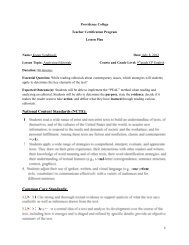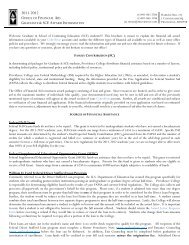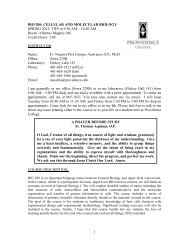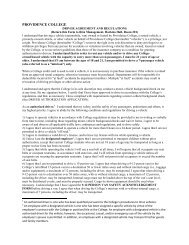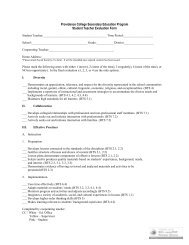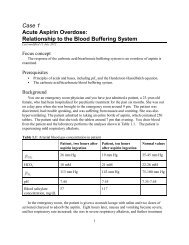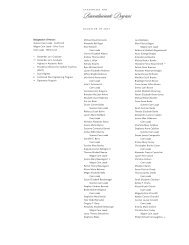Case 18 Purification of Phosphofructokinase 1-C
Case 18 Purification of Phosphofructokinase 1-C
Case 18 Purification of Phosphofructokinase 1-C
Create successful ePaper yourself
Turn your PDF publications into a flip-book with our unique Google optimized e-Paper software.
<strong>Case</strong> <strong>18</strong><br />
<strong>Purification</strong> <strong>of</strong> Phosph<strong>of</strong>ructokinase 1-C<br />
Last modified 11 July 2012<br />
Focus concept<br />
The purification <strong>of</strong> the C isozyme <strong>of</strong> PFK-1 is presented and the kinetic properties <strong>of</strong> the purified<br />
enzyme are examined.<br />
Prerequisites<br />
<br />
<br />
<br />
Protein purification techniques.<br />
Enzyme kinetics and inhibition.<br />
The glycolytic pathway.<br />
Background<br />
In this case, Foe and Kemp purified the isozyme phosph<strong>of</strong>ructokinase-1 C (PFK-1 C) from brain<br />
tissue. There are three isozymes <strong>of</strong> PFK-1 and they are designated A, B, and C. The A isozyme (M r =<br />
84,000 dal) is found in the muscle and the brain; the B isozyme (M r = 80,000 dal) is found in the liver and<br />
the brain; and the C isozyme (M r = 86,000) is found in the brain. Because the brain contains all three<br />
isozymes and there isn’t a location where the C isozyme is found exclusively, the enzyme has been<br />
difficult to purify. In this case, the investigators purified the desired enzyme to homogeneity, and also<br />
presented ample evidence that the C isozyme is distinct from the A and B isozymes. The availability <strong>of</strong> a<br />
pure C preparation means that antibodies can be generated which can be used to detect the isozyme.<br />
Since the levels <strong>of</strong> PFK-1 isozymes have been shown to change during malignant transformation <strong>of</strong> cells,<br />
the availability <strong>of</strong> a C antibody might be a valuable diagnostic tool.<br />
Questions<br />
1. To accomplish the purification, rabbit brain tissue was homogenized and centrifuged to remove<br />
insoluble material. Next, the soluble preparation was loaded on top <strong>of</strong> an ATP-Sepharose column.<br />
This is an affinity column in which ATP is covalently linked to a polysaccharide bead. The sample is<br />
loaded on top <strong>of</strong> the column, washed with a low-salt buffer, followed by a wash with a high salt<br />
buffer. What is the rationale for using this procedure? Draw a diagram <strong>of</strong> the expected elution pr<strong>of</strong>ile.<br />
2. Next, the fractions containing PFK-1 activity were applied to a DEAE-Sephadex (anion exchange)<br />
column. The column was equilibrated with a pH = 8.2 buffer. The column was eluted with a salt<br />
(ammonium sulfate) gradient and the results are shown in Figure <strong>18</strong>.1. Using the elution pr<strong>of</strong>ile as<br />
well as the results from SDS-PAGE analysis shown in Figure <strong>18</strong>.2, identify which isozyme is found in<br />
each <strong>of</strong> the two peaks. How might the amino acid composition <strong>of</strong> PFK-1 B differ from that <strong>of</strong> PFK-1<br />
A and C based on the manner <strong>of</strong> elution from the DEAE column?<br />
1
CASE <strong>18</strong> <strong>Purification</strong> <strong>of</strong> Phosph<strong>of</strong>ructokinase 1C<br />
Figure <strong>18</strong>.1: <strong>Purification</strong> <strong>of</strong> PFK-1C by DEAE Sephadex (anion exchange)<br />
chromatography (based on Foe and Kemp, 1985).<br />
Figure <strong>18</strong>.2: SDS-PAGE analysis <strong>of</strong><br />
the PFK-1C purification. Lane 1:<br />
Molecular weight standards. Lane 2:<br />
Eluant from the ATP-Sepharose affinity<br />
column. Lane 3: Pooled fractions 16-26<br />
from the DEAE-Sephadex column.<br />
Lane 4: Pooled fractions 55-60 from the<br />
DEAE-Sephadex column. Lane 5:<br />
Fractions 30-35 from the CM-52<br />
column (elution pr<strong>of</strong>ile shown in Figure<br />
<strong>18</strong>.3). Lane 6: Fractions 41-50 from the<br />
CM-52 column (based on Foe and<br />
Kemp, 1985).<br />
2
CASE <strong>18</strong> <strong>Purification</strong> <strong>of</strong> Phosph<strong>of</strong>ructokinase 1C<br />
3. Next, the investigators took Fractions 16-26 from the DEAE-Sephadex column, pooled them, and<br />
adjusted the pH to 5.0. This preparation was then loaded onto a CM-52 (cation exchange) chromatography<br />
column and eluted with a pH gradient. Fractions 30-35 were collected and pooled, as were<br />
Fractions 41-50. Identify the peaks in the chromatogram in Figure <strong>18</strong>.3, using information in the<br />
SDS-PAGE gel. Based on their elution from the cation exchange column, how might the amino acid<br />
compositions <strong>of</strong> these two proteins differ?<br />
4. Write the reaction catalyzed by PFK-1.<br />
Figure <strong>18</strong>.3: Cation exchange chromatography <strong>of</strong> PFK-1 (based on Foe<br />
and Kemp, 1985).<br />
5. There are several allosteric effectors that influence the activity <strong>of</strong> PFK-1 in the cell. What are they?<br />
List both activators and inhibitors <strong>of</strong> the enzyme.<br />
6. The investigators next carried out kinetic studies using their newly purified PFK-1C isozyme. They<br />
studied the catalytic behavior <strong>of</strong> the enzyme in the presence <strong>of</strong> the metabolites AMP, inorganic<br />
phosphate (P i) and fructose-2,6-bisphosphate (F-2,6-BP). The results are shown in Figure <strong>18</strong>.4.<br />
Additional information concerning the three isozymes’ response to allosteric effectors is presented in<br />
Tables <strong>18</strong>.1 and <strong>18</strong>.2.<br />
a. Compare the ability <strong>of</strong> PFK-1C to catalyze the phosphorylation <strong>of</strong> fructose-6-phosphate in the<br />
absence <strong>of</strong>, and in the presence <strong>of</strong> AMP, F-2,6-BP or P i . How do these allosteric effectors<br />
influence the velocity <strong>of</strong> the reaction?<br />
b. Evaluate whether the investigators have shown that PFK-1 C is different from the PFK-1 A and<br />
PFK-1 B isozymes. Speculate why there might be functional differences among the isozymes.<br />
3
CASE <strong>18</strong> <strong>Purification</strong> <strong>of</strong> Phosph<strong>of</strong>ructokinase 1C<br />
Figure <strong>18</strong>.4: Activation <strong>of</strong> PFK-1C. V is V max and is defined as the<br />
activity at 0.5 mM ATP, 10 mM F6P, and 2 mM phosphate (based<br />
on Foe and Kemp, 1985).<br />
Table <strong>18</strong>.1: Relative potency <strong>of</strong> the allosteric effector citrate on PFK isozymes. The concentration<br />
given is the micromolar concentration <strong>of</strong> citrate required to inhibit 50% <strong>of</strong> the enzyme activity.<br />
Isozyme<br />
A 100<br />
Citrate, ìM<br />
B > 2000<br />
C 750<br />
Table <strong>18</strong>.2: Relative potency <strong>of</strong> allosteric effectors on PFK isozymes. Numbers given are the<br />
micromolar concentrations <strong>of</strong> each effector required to achieve 50% <strong>of</strong> the maximal velocity.<br />
Isozyme Phosphate AMP Fructose-2,6-BP<br />
A 80 ìM 10 ìM 0.05 ìM<br />
B 200 ìM 10 ìM 0.05 ìM<br />
C 350 ìM 75 ìM 4.5 ìM<br />
Reference<br />
Foe, L. G., and Kemp, R. G. (1985) J. Biol. Chem. 260 pp. 726-730.<br />
4




